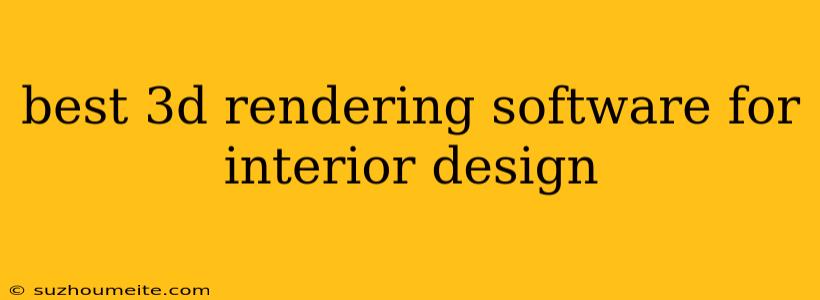Best 3D Rendering Software for Interior Design
3D rendering is an essential tool for interior designers to visualize and communicate their designs to clients. It allows you to create realistic and immersive representations of spaces, showcasing furniture, materials, and lighting in a way that 2D drawings simply cannot.
With so many different 3D rendering software options available, it can be overwhelming to choose the right one for your needs. This article will explore some of the best 3D rendering software for interior design, considering factors such as ease of use, features, cost, and overall performance.
Top Picks for Interior Design Rendering
Here are three of the best 3D rendering software options for interior designers, each with its own unique strengths:
1. Lumion:
- Strengths: User-friendly interface, excellent rendering speed, and a vast library of 3D objects and materials.
- Ideal for: Interior designers who prioritize speed and ease of use.
- Pros:
- Intuitive interface: Lumion's interface is very user-friendly, making it easy to learn and use, even for beginners.
- Fast rendering: Lumion is known for its incredibly fast rendering speeds, allowing you to quickly create stunning visuals.
- Extensive library: Lumion offers a vast library of high-quality 3D objects, materials, and textures, which can save you time and effort.
- LiveSync: This feature allows you to see changes in your design in real-time as you work, which is great for quick iterations.
- Cons:
- Limited customization: Some users may find the customization options in Lumion to be limited.
- Price: Lumion can be relatively expensive, especially for individual users.
2. Twinmotion:
- Strengths: Real-time rendering, intuitive interface, and powerful features for creating realistic environments.
- Ideal for: Interior designers who need a tool for quick and interactive presentations.
- Pros:
- Real-time rendering: Twinmotion allows you to see your renderings update instantly, providing a very interactive design experience.
- User-friendly interface: Similar to Lumion, Twinmotion is relatively easy to learn and use, even for beginners.
- Realistic environments: Twinmotion includes powerful features for creating realistic environments, such as advanced lighting and materials.
- Collaboration features: Twinmotion makes it easy to collaborate with clients and colleagues on projects.
- Cons:
- Limited customization: Similar to Lumion, some may find the customization options in Twinmotion to be limited.
- Price: Twinmotion can be expensive, particularly for individual users.
3. Blender:
- Strengths: Free and open-source, incredibly powerful and customizable, and a large and active community.
- Ideal for: Interior designers who want a powerful tool with a steep learning curve and a large support network.
- Pros:
- Free and open-source: Blender is completely free to use and open-source, making it an attractive option for budget-conscious designers.
- Powerful features: Blender is incredibly powerful and offers a wide range of features for creating complex and highly detailed models.
- Extensive community: Blender has a large and active community of users who can provide support and resources.
- Cons:
- Steep learning curve: Blender has a steep learning curve, especially for beginners.
- Less intuitive interface: Compared to Lumion and Twinmotion, Blender's interface can be less user-friendly.
Choosing the Right Software for You
Ultimately, the best 3D rendering software for you will depend on your specific needs and budget. Consider the following factors:
- Budget: Software costs vary widely, so make sure to consider this before you make your decision.
- Ease of use: If you're new to 3D rendering, you may want to choose a software with a user-friendly interface.
- Features: Consider the features you need, such as real-time rendering, advanced lighting, and materials.
- Support: Look for software with a strong community or good customer support.
It's also helpful to try out different software options using free trials or demos to see which one best suits your workflow and preferences.
